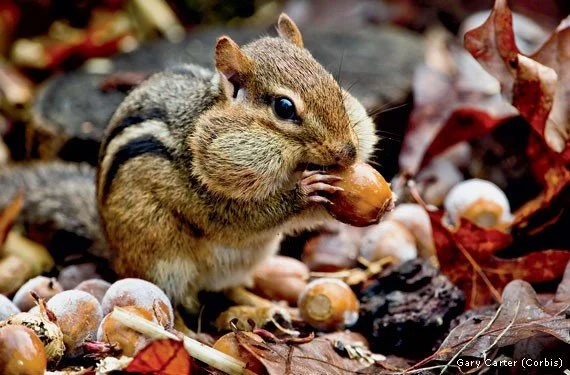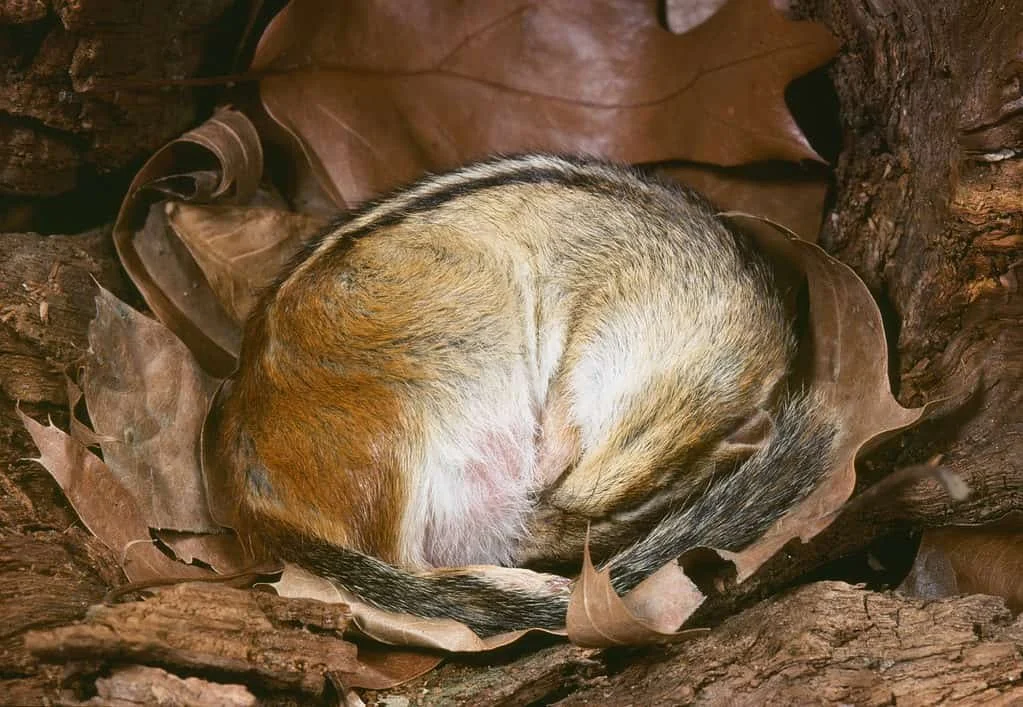Eastern Chipmunk
(Tamias striatus)
Fast Facts
Where: Wide variety of settings ranging from forests, shrublands, meadows, backyards, and parks
Size: 2-5 oz., 3-4.5 inches long, with a 3-4 inch long tail
Diet: Variety of nuts, seeds, fruits, berries, mushrooms, worms, insects, amphibians, bird eggs, and some baby birds
Activity: Active in the Northeast from Spring-Fall; remain underground in burrows throughout the winter.
Are solitary except for when female is raising her young.
Live most of life in underground burrows where they rest and sleep, raise young, store food, and overwinter.
Spend much of their active time above-ground searching for food; much of the food that they collect they store away in their burrows to sustain them through the winter.
Reproduction: Males typically emerge from overwintering ~1-2 weeks before females.mate with females shortly after females emerge.
Female has litter most commonly contains 2-6 young (“pups” or “kits”).
Spend much of their active time above-ground searching for food; much of the food that they collect they store away in their burrows to sustain them through the winter.
They are solitary except for when female is raising her young.
Female typically has two litters each year; each litter most commonly contains 2-6 young (“pups” or “kits”).
Spend winter in a repeated periods of “torpor” whereby they enter a type of deep sleep for several days at a time during which their heart rate, metabolism, and body temperature drops dramatically. Then they wake up briefly to eat and dispose of their waste and then return back into a torpor state.
They don’t hibernate as they are unable to accumulate enough fat to last them through an entire winter.
They can live up to ~8 years in the wild, though most live less than 2-3 years.
The Eastern Chipmunk is a solitary species, and aside from the time when a female is raising her young on her own and the very short time (often just a matter of minutes) when a male and female are mating, they spend the rest of their life alone. Eastern Chipmunks are active in New England from spring-fall and remain underground in their burrows throughout the winter in a hibernation-like state known as “torpor” (see here for a comparison of torpor and hibernation).
Food, Food, and More Food
Eastern Chipmunks spend much of their active time above-ground searching for food, primarily nuts, seeds, berries, and fruits, and to a lesser extent mushrooms, worms, insects, amphibians, bird eggs, and sometimes baby birds. Much of the food they collect they store away in their burrows to sustain them through the winter. By the start of winter, a single chipmunk may have a gallon-and-a-half worth of seeds and nuts stored for the winter months, which can equal upwards of 5,000 seeds/nuts.
Often Eastern Chipmunks will also “scatter hoard” some of the food they have collected, which is a behavior whereby they hide/bury food items in different areas throughout their home-range in order to access them at a later date. Scatter-hoarding helps to provide them a backup food supply should their collection of food (“hoard”) in their burrow be stolen by another chipmunk or another animal. (see here for a comparison of “larder-hoarding” and “scatter-hoarding”)
A Burrow Lifestyle
When not out-and-about searching for and collecting food, they spend most of their life in their underground burrow system. They use these burrows as safe places to rest, overwinter, raise their young, store food, and escape from harsh weather in.
They often construct their burrow systems themselves, frequently partially using old root channels through the soil. Some will live in an existing burrow system that is no longer occupied by the original resident chipmunk.
Eastern Chipmunk burrows are often made up of two or three levels of connected underground tunnels that run more or less parallel with the ground surface. One level contains a widened chamber partially lined with leaves and grass (their “nest”) which is where they rest/sleep and where the female raises her young, and the other one or two levels has widened chambers which is where they store their food (their “hoards”). Additionally, they often dig drainage tunnels extending straight down from the lowest tunnel to drain water and keep the burrow system dry. The entire burrow system is typically within three feet of the ground surface.
There is usually one main entrance that they use to enter and exit their burrow system and one, or multiple, other entrances that are plugged with leaves and debris which are designed as a backup should the tunnel to the main entrance collapse, or as an alternate escape route from predators.
Baby “Chippies”
Adult female Eastern Chipmunks will typically have two litters each year, the first in spring and the second in late-summer. Each litter most commonly is made up of 2 - 6 young (called “pups” or “kits”) which are born after an ~ 31-day gestation period. At birth the young are blind, without fur, and are about the size of a bumblebee. The mother will raise them entirely by herself and they will nurse from her and will remain in the nest for their entire first month of life.
The young grow quite quickly and by 1-month-old their eyes will open and they are completely covered in fur. At ~6 weeks old they begin to take aboveground forays from the burrow learning to gather food and become more comfortable with their surroundings. They will gradually travel further and further from their burrows over the next ~2 weeks. At ~8-10 weeks old they are forced by their mother to leave her burrow and to find their own home-range and burrow system to live in.
Annual Activity Pattern
Eastern Chipmunks begin their above-ground surface activity each year with warming temperatures in early spring. Males often emerge from their winter retreats earlier than females, typically 1-2 weeks earlier, and pretty soon thereafter are quite focused on finding a female(s) to mate with. Eastern Chipmunks can breed at ~1 year old, and the first of the two breeding seasons in a year often occurs within a week after the female emerges in early spring; the second breeding season occurs during mid-to-late summer.
Adults are very active above-ground from early-spring until ~early-July, primarily feeding and collecting food to store in their burrow. Exceptions to this are that females will remain underground for the first several days after giving birth to their first litter of the year, and adults will retreat to their burrows during very inclement weather during this time. They are only active above-ground during the daytime (they are a “diurnal” species) and remain in their burrows at night.
During mid-summer (~July and August) Eastern Chipmunks reduce surface activity which is due to a combination of hot temperatures, reduced food availability, and increased botfly parasitism risk during this time period. Their second breeding season of the year typically occurs between June – July, which somewhat overlaps this period of reduced surface activity, and is one exception to this pattern. There is then another peak in surface activity from the end of summer into ~early/mid-fall when they are hyper-focused on continuing to gather food to last them through the winter.
By mid-to-late November in New England most Eastern Chipmunks have entered their burrow systems and have begun their overwintering “torpor”. This is a type of hibernation-like condition whereby their heart rate drops to < 10 beats per minute (compared to ~ 350 beats per minute during the active season) and their body temperature drops to ~ 40-45°F (compared to ~ 94°F during the active season). They “wake-up” briefly every few-to-several days to eat and dispose of their waste, and then return back to their torpor. They are unable to accumulate enough fat to last them through an entire winter which is why they can’t truly hibernate.
Observations by Month
The plots above show the number of observations of Eastern Chipmunks for each month for each New England State from iNaturalist through 2022. You’ll note a general trend of much reduced sightings in Winter, an increasing number of sightings throughout the Spring and early-Summer; reduced sightings in July and August, followed by another increase in sightings in early-Fall until the onset of Winter.
How You Can Help Them
If you have cats, keep them entirely indoors or in a wildlife-safe outdoor enclosure; domestic cats are major predators of chipmunks (and of a wide variety of other wildlife species)
Provide woodpiles and/or brush piles in your yard; chipmunks readily use these for cover from predators
Convert part of your yard to native wildflower meadows; among many other benefits of doing this, this creates a source of seeds for chipmunks and provides them cover from predators












